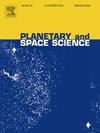基于LROC WAC数据分析的月球表面亮度新经验相位函数作为月球遥感工具
IF 1.7
4区 物理与天体物理
Q3 ASTRONOMY & ASTROPHYSICS
引用次数: 0
摘要
对月球表面亮度相函数的各种表达式进行了比较,并对其在减少光度观测和解决月球表面遥感问题方面的应用提出了建议。通过对LROC WAC数据的分析,提出了一种新的经验相位χ函数。它只有两个自由参数,但它允许定性逼近玛丽亚和高地不同性质的形态形成的亮度相位曲线,因此它对观测数据的光度还原是有用的。该函数的参数χ不依赖于反照率(波长),可以作为月球表面结构特征的评估,有助于解决月球表面遥感问题。该函数的参数χ也可以作为探测月球表面新的光度异常的有效工具。研究结果适用于任何地形复杂的无大气地表的遥感。本文章由计算机程序翻译,如有差异,请以英文原文为准。
New empirical phase function of the lunar surface brightness derived from analysis of LROC WAC data as a tool for remote sensing of the Moon
A comparison of various expressions of phase function of brightness of the lunar surface was carried out and recommendations were given for their use for the reduction of photometric observations and solving the problems of remote sensing of the lunar surface. A new empirical phase χ-function derived from analysis of LROC WAC data is proposed. It has only two free parameters, but it allows for qualitative approximation of phase curves of the brightness for morphological formations of different nature both for Maria and Highlands, thus it is useful for photometric reduction of observation data. Parameter χ of this function does not depend on albedo (wavelength) and can serve as an assessment of the structural characteristics of the lunar surface, which is useful for solving the problems of remote sensing of the lunar surface. Parameter χ of this function also can serve as an effective tool for detecting new photometric anomalies on the surface of the Moon.
The results of the work are applicable for remote sensing of any atmosphereless surfaces of with complex topography.
求助全文
通过发布文献求助,成功后即可免费获取论文全文。
去求助
来源期刊

Planetary and Space Science
地学天文-天文与天体物理
CiteScore
5.40
自引率
4.20%
发文量
126
审稿时长
15 weeks
期刊介绍:
Planetary and Space Science publishes original articles as well as short communications (letters). Ground-based and space-borne instrumentation and laboratory simulation of solar system processes are included. The following fields of planetary and solar system research are covered:
• Celestial mechanics, including dynamical evolution of the solar system, gravitational captures and resonances, relativistic effects, tracking and dynamics
• Cosmochemistry and origin, including all aspects of the formation and initial physical and chemical evolution of the solar system
• Terrestrial planets and satellites, including the physics of the interiors, geology and morphology of the surfaces, tectonics, mineralogy and dating
• Outer planets and satellites, including formation and evolution, remote sensing at all wavelengths and in situ measurements
• Planetary atmospheres, including formation and evolution, circulation and meteorology, boundary layers, remote sensing and laboratory simulation
• Planetary magnetospheres and ionospheres, including origin of magnetic fields, magnetospheric plasma and radiation belts, and their interaction with the sun, the solar wind and satellites
• Small bodies, dust and rings, including asteroids, comets and zodiacal light and their interaction with the solar radiation and the solar wind
• Exobiology, including origin of life, detection of planetary ecosystems and pre-biological phenomena in the solar system and laboratory simulations
• Extrasolar systems, including the detection and/or the detectability of exoplanets and planetary systems, their formation and evolution, the physical and chemical properties of the exoplanets
• History of planetary and space research
 求助内容:
求助内容: 应助结果提醒方式:
应助结果提醒方式:


